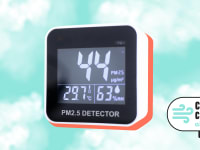You may want to consider getting an indoor air quality monitor—here’s why
How this device can improve indoor air quality
Products are chosen independently by our editors. Purchases made through our links may earn us a commission.
Check out the entire Climate Control series to protect your home from the effects of climate change
Climate change impacts the air we breathe in many different ways. It exacerbates the length and severity of pollen season, and it can increase the gasses and pollutants that can pop up in your home.
One way you can identify and address these potential hazards, which can affect you and your health, is by using an air quality monitor at home.
If you’ve never considered an air quality monitor, we’ll explain just what they do, what kinds of pollutants they identify, and why it’s important.
What does an air quality monitor do?
While the EPA has created the Air Quality Index (AQI) to monitor and communicate any current hazards relating to outdoor air quality, it’s just as important to monitor the air inside our individual homes, too.
Air quality monitors are able to identify mold and fungi as well as particulates in your home that are the side effects of cooking, smoke, dust, or even the off-gassing of household chemicals containing VOCs.
Perhaps most crucially, they also detect the presence of harmful pollutants, including carbon monoxide and carbon dioxide, and radon, the radioactive compound that is the second-leading cause of lung cancer behind smoking.
The EPA reports that elevated levels of radon are found in one in every 15 homes, and while radon can be found all across the country, it is much more prevalent across the northern half of the United States.
Many air quality monitors can identify sub-optimal temperatures and humidity, which can typically be easily remedied, but the dangerous stuff, like carbon monoxide, VOCs, and radon, is what we’ll be focusing on.
It’s important to note that air quality monitors are not air purifiers.
While many air purifiers have built-in monitors and can identify and remove all kinds of particulates, including pollen, dust, and mold spores, as well as certain gasses, air quality monitors are designed to offer up-to-the-minute reads on everything from a room’s temperature and humidity to its carbon monoxide and carbon dioxide levels, and radon and VOC concentration.
Most can push the results to a smartphone or computer via built-in apps.
Who should use an air quality monitor?
Considering the fact that most air quality monitors are able to identify several common pollutants and gasses that can be a cause for concern, it’s a great idea for everyone to have at least one in your home.
Residents of areas with a higher-than-normal concentration of wildfires will likely take some comfort in knowing the levels of particulate matter in their area are a result of smoke, and can act on any concerning levels accordingly.
Likewise, people who live in homes where radon is known to be an issue can monitor and test on an ongoing basis, and can pursue radon mitigation or reduction if needed.
Paul Walsh, the general manager at the air quality data service BreezoMeter, states that air quality monitors are especially helpful for people living in cities where air quality—and its impacts—are at their worst.
He cautions, “That’s where the traffic is, you have the urban heat island, and ozone impact is higher.”
To that end, he says knowing that residents can seek refuge indoors when outdoor air quality isn’t optimal, would provide a much-needed respite for city-dwellers.
For some, the question of whether or not to get an air quality monitor is less about where you live and more about underlying conditions. Some people with asthma or other lung or breathing issues might find the information delivered by a monitor helpful to gauge whether or not they should stay inside or retreat elsewhere if conditions are poor.
Should anyone not use an air quality monitor?
Director of University of California, Davis’s Air Quality Research Center Anthony Wexler says there might be some people for whom too much information is not a good thing.
“[Monitors] are good for increasing awareness, and that’s good, as long as it’s not increasing anxiety. Anxiety can be just as bad as air pollution, as far as health impacts, so for some people it’s not a good idea to know.”
One question that has been on a lot of minds over the last few years is whether or not an air quality monitor can detect Covid-19 particles, and whether an air purifier can eliminate them.
Unfortunately, the answer is no. If you’re thinking of employing an air quality monitor for that reason, the EPA states that while “air purifiers can help reduce airborne contaminants, including viruses in a home or confined space, by itself, a portable air cleaner is not enough to protect people from COVID-19.”
Which air quality monitor should I buy?

When we tested the Amazon Indoor Air Quality Monitor we found it to be both functional and useful for buyers.
One of the most popular and highly rated air quality monitors available is the Amazon Indoor Air Quality Monitor, which we tested and found to be user-friendly and compatible with Alexa Routines.
One caveat though, is that while it does track particulate matter (PM 2.5), VOCs, carbon monoxide (CO), humidity, and temperature, it does not measure radon.
To incorporate radon, we suggest the pricier, but highly rated Airthings House Kit Plus. An added feature of the Airthings kit is that it also tracks pollen data. All daily readings are available either via app or it can be integrated into your smart home features.


